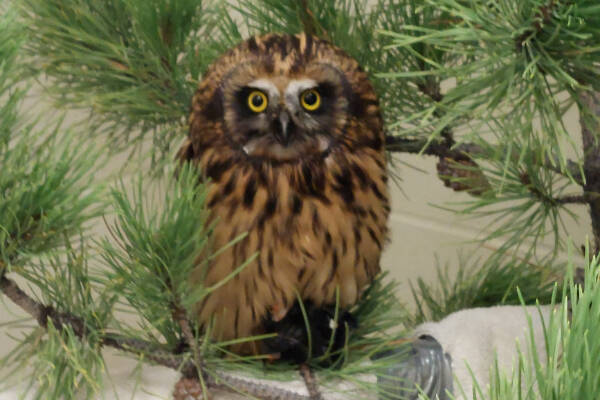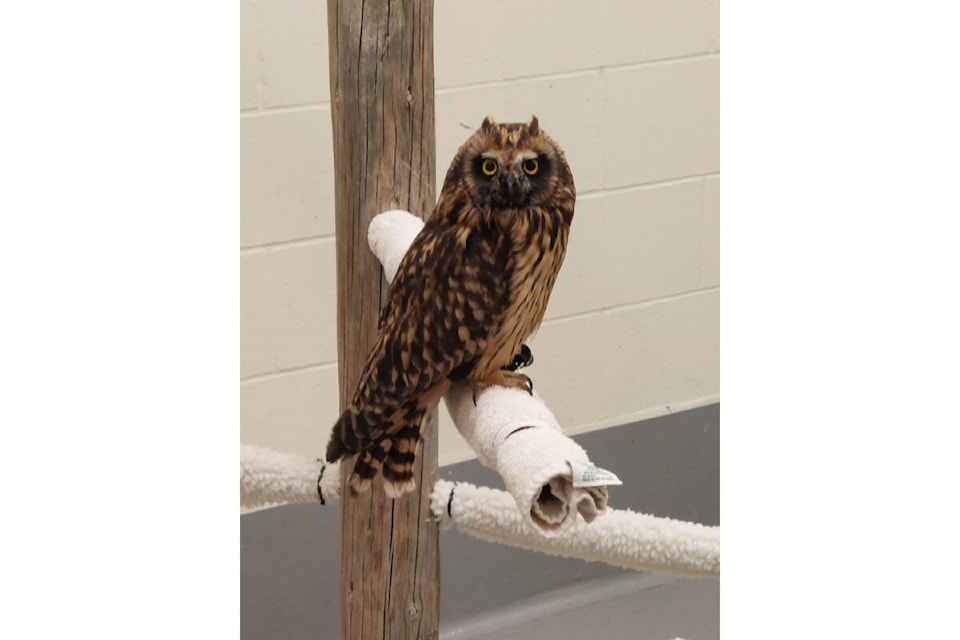A charismatic (albeit rather grumpy) avian friend has received an unlikely new lease on life; in mid-May, the Yukon Wildlife Preserve successfully released a severely injured female short-eared owl after months of intensive care and rehabilitation.
Unlike their resident cousins, the boreal owl and the great-horned owl, short-eared owls (Asio flammeus) are not “true” Yukoners, but migratory summer residents who journey to the territory to breed. A medium-sized owl standing 34-42 cm tall and wing-span of up to a meter, strikingly handsome, they sport tawny mottled plumage with a cream-coloured buff, two short, stubby tufts at the top of their heads (hence their name, “short-eared”) and tell-tale black, triangular patches around their luminously yellow eyes which make the bird look like they’re about to go thrash at a KISS concert. Unlike most owls, the species is crepuscular — meaning they’re most active at dawn and dusk–and therefore humans are more likely to see them. They hunt in fields and marshes, dining largely on rodents, and are known for their long, low, “moth-like” wing beats.
This unlucky lady was brought to the preserve in August 2021 after having been struck by a car, says Erica Sisson, an animal care assistant who works there. X-rays showed the bird had fractured both her legs — a particularly horrific injury for an owl, who uses their feet to not only perch and walk, but to hunt, falling on prey from above and seizing them in their powerful talons and carrying them off. In a human, it would be comparable to having both your hands broken — unpleasant, difficult and debilitating for us, but a death sentence for an owl in the wild.
In the case of this particular owl, it meant a long — and uncertain — recovery, Sisson said.
After the initial triage process, Sisson and the preserve’s veterinary team had to bandage the bird’s legs to keep them immobile as possible, as with both limbs fractured any extra pressure or pusing was incredibly hard on the animal. The bandages had to be changed often, and a close eye kept on the healing process.

After it was determined that the fractures had healed, the next step was physiotherapy and laser therapy; just as in people, if you break something and don’t use it while it’s healing, muscles atrophy, and need care and rehabilitation to get back to full strength.
“Once a day, we’d get her out, do some leg stretches, kind of rotate her ankles to make sure the feet and everything were still in good shape,” Sisson said. “When she was able to have the bandages off we put her in a bigger enclosure so she could fly around and work out its wings, because we needed to get that wing strength back up.
“When we figured out that her feet were in good shape, we actually started putting live food in [the enclosure] in order of different sizes, because we wanted to see how well it was using its feet, [watching] how it was … grabbing [prey] to make sure that if we did release it, it would be able to hunt in the wild.”
As you would think, this kind of avian rehabilitation is a lengthy, delicate process, and one that involves a lot of close contact between a person — in this case Sisson, the bird’s primary caregiver — and a rather large, unhappy predatory bird equipped with talons and a beak designed, by their very nature, to rip and tear. Sisson noted that some owl species tolerate human handling quite well: boreal or hawk owls, for example, are relatively mellow. Short-eared owls — or, at any rate, this particular short-eared owl — was “not a fan,” she said, which made care “a little bit more difficult.”
“Typically, if I would go into a room with it, it would pop up and do what I would call a scream,” Sisson says. “It would just scream at me — they didn’t want me that close, which is understandable.
“It usually took a couple of us, with a little net, and some towels to calmly get it to the ground and wrap it up so it didn’t get hurt. It was definitely not a fan of being touched that much, and I don’t blame it,” Sisson said, with a chuckle. “But thankfully, once the legs had healed and we didn’t have to do therapy on it every day, it was a lot better for [the owl].”
The owl, as readers are surely wondering, does not have a name. Naming animal patients makes it harder for staff like her not to get attached to them when they’re ultimately released, Sisson said.
Despite the careful ministrations of staff like Sisson, there was definitely a time when the owl’s recovery was really touch-and-go, she said. They weren’t sure it would ever be able to use its legs again, and at a certain point her injuries were so severe the team had to seriously consider if recovery was feasible, or if euthanization were the kinder option.
“To make the decision to either euthanize it or continue doing therapy, that was a tough decision — it always is,” Sisson said. “It was an amazing experience, being able to release it again, after having (been faced) with that decision.”
“I always want to keep trying, but sometimes you can’t — that’s one of the hardest parts of this job. But it was apparently the right choice because now it’s back out in the wild where it belongs. And I’m pretty happy.”
Once the owl was able to fly and they determined it could hunt and take care of itself, it had to be slowly reconditioned to the outside climate, having lived indoors for much of the winter. By mid-May, however — nine months after her initial injury — the owl was finally ready to return to the wild. A short video of the release is available through the Yukon Wildlife Preserve’s website.
Although many Yukoners love animals and always want to help our feathered friends in need, special precautions and considerations should be taken at this time, due to the confirmed presence of avian flu in the territory.
To report sick or dead birds, Yukoners should call, 867-667-5838 or email agriculture-livestock@yukon.ca.
Lori Fox is a writer and journalist based in Whitehorse. Their first book, This Has Always Been A War, was released on May 3.
